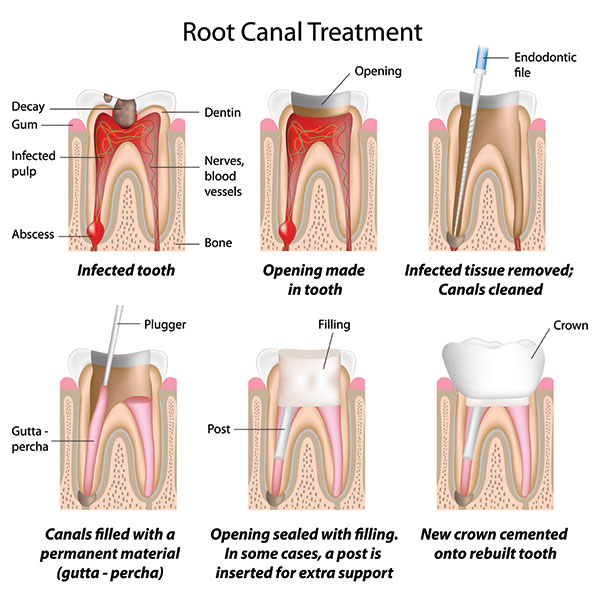What is Root Canal Treatment?

Root canal treatment (RCT) is one type of endodontic treatment, which is performed to save a tooth that is severely decayed or infected. It involves removing the damaged or infected pulp (soft tissue) from inside the tooth, cleaning and disinfecting the root canals, and then filling and sealing them. The primary goal of RCT is to remove the infection, alleviate pain, and save the natural tooth from extraction. It allows for the restoration of normal tooth function, appearance, and the ability to bite and chew comfortably
The pulp contains nerves and blood vessels, and when it becomes infected or inflamed, can cause intense pain and potential tooth loss if left untreated. RCT aims to alleviate pain, eliminate infection and restore the tooth’s structure and function. After the procedure, a dental crown or filling is usually placed on the treated tooth to protect it and restore its appearance.
Why Would I Need Root Canal Treatment?
There are a few reasons why you might need RCT.
1. Tooth Decay: When tooth decay progresses deep into the tooth, it can reach the pulp causing infection and inflammation.
2. Dental Trauma: If a tooth is cracked, fractured or injured due to trauma, the pulp can be exposed to bacteria leading to infection.
3. Dental Abscess: An abscess is a pus-filled pocket that forms at the root of a tooth due to bacterial infection. RCT is required to remove the infection and prevent its spread.
4. Deep Dental Fillings: Large or deep dental fillings close to the pulp can cause irritation and inflammation. If the pulp becomes infected, RCT is necessary to resolve the issue.
5. Tooth Sensitivity and Pain: If a tooth is tender to percussion and sensitive to hot or cold temperatures, this could indicate pulp inflammation / infection.
Cost of Root Canal Treatment
The cost of root canal treatment depends on the number of canals the affected tooth has. The number of canals can only be known during the operation when the tooth is drilled to expose the pulp chamber, but generally, incisors and canines have 1 canal, premolars 2, and molars 3 or more canals.
CHAS subsidises up to 2 root canal treatments per calendar year. View the CHAS subsidy table 
Root Canal Treatment
- 1 canal: $650 - $750
- 2 Canal: $800 - $950
- 3 or more Canals: $1200 - $1600
What To Expect

~90 mins
Steps involved:
- A periapical x-ray will be taken.
- Local anaesthesia administered to ensure you are comfortable during the procedure
- A small access hole will be created to reach the infected pulp chamber and root canals.
- Our Drs will remove the infected pulp and flush the canals with disinfecting solution.
- Once the canals are cleaned, they are filled up to seal the canals.
- The access hole is then sealed with a filling.
Post-Treatment:
- We would schedule a follow-up review for about 2 weeks later to monitor the tooth’s healing, and evaluate for a placement of a permanent restoration such as a dental crown.
Frequently Asked Questions
Other than root canal treatment, patients can opt to extract the tooth and leave the remaining gap be, or place an implant to replace the tooth.
Due to the removal of the pulp and the drilling of the tooth to access the pulp chamber, the tooth’s structural integrity will be compromised. Without the support of a crown, the treated tooth will be more prone to fracture. Hence, it is highly recommended to crown the tooth after root canal treatment for teeth that experience strong forces such as the premolars or molars.
Infection occurs on living tissue, ie – the pulp. Removing the pulp prevents re-infection
This can vary depending on whether the patient grinds their teeth / whether the treatment was done well / maintenance of oral hygiene post treatment / whether or not a crown was placed post treatment.
With proper treatment and maintenance, root canal treated teeth can last a lifetime!


